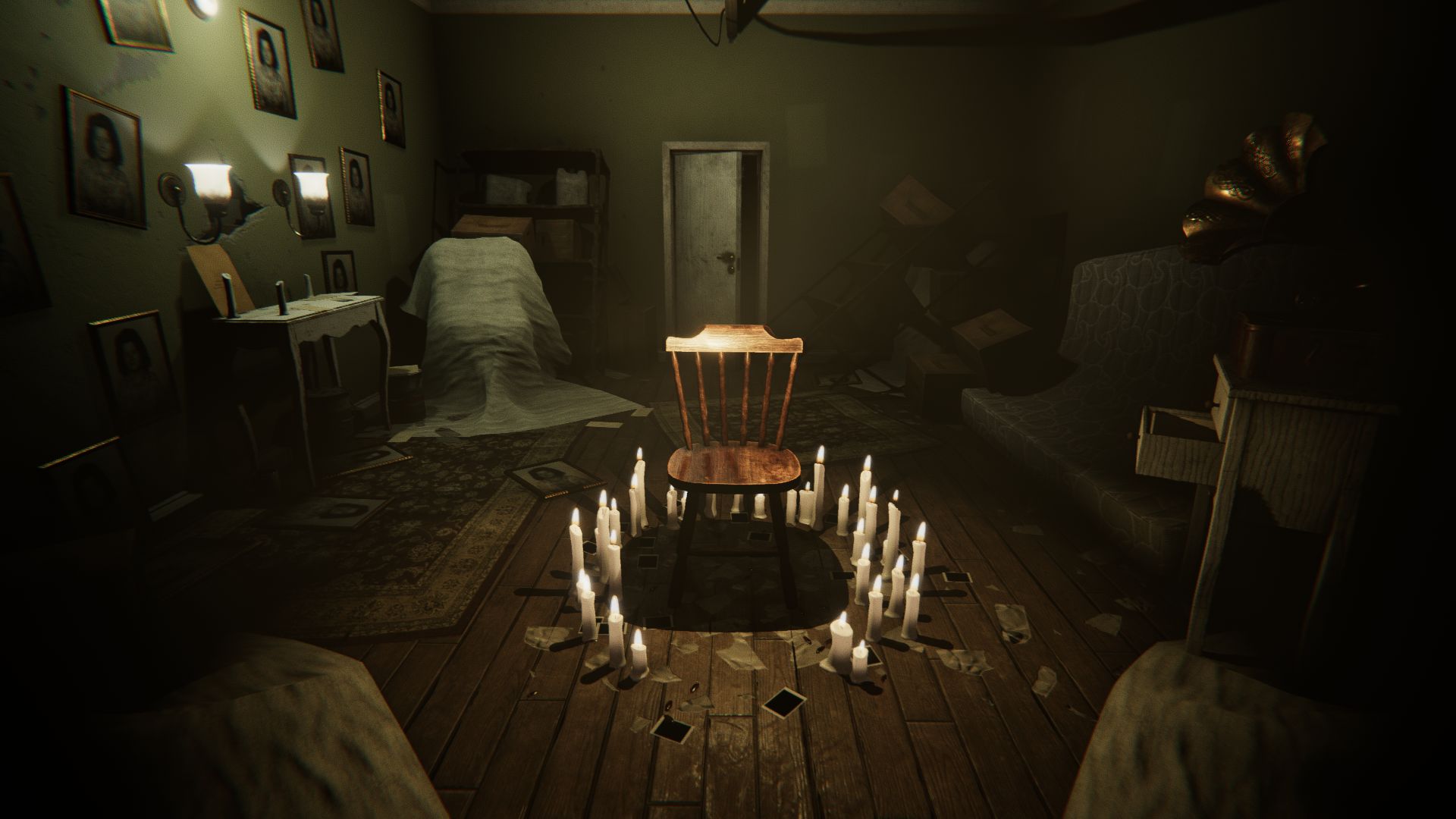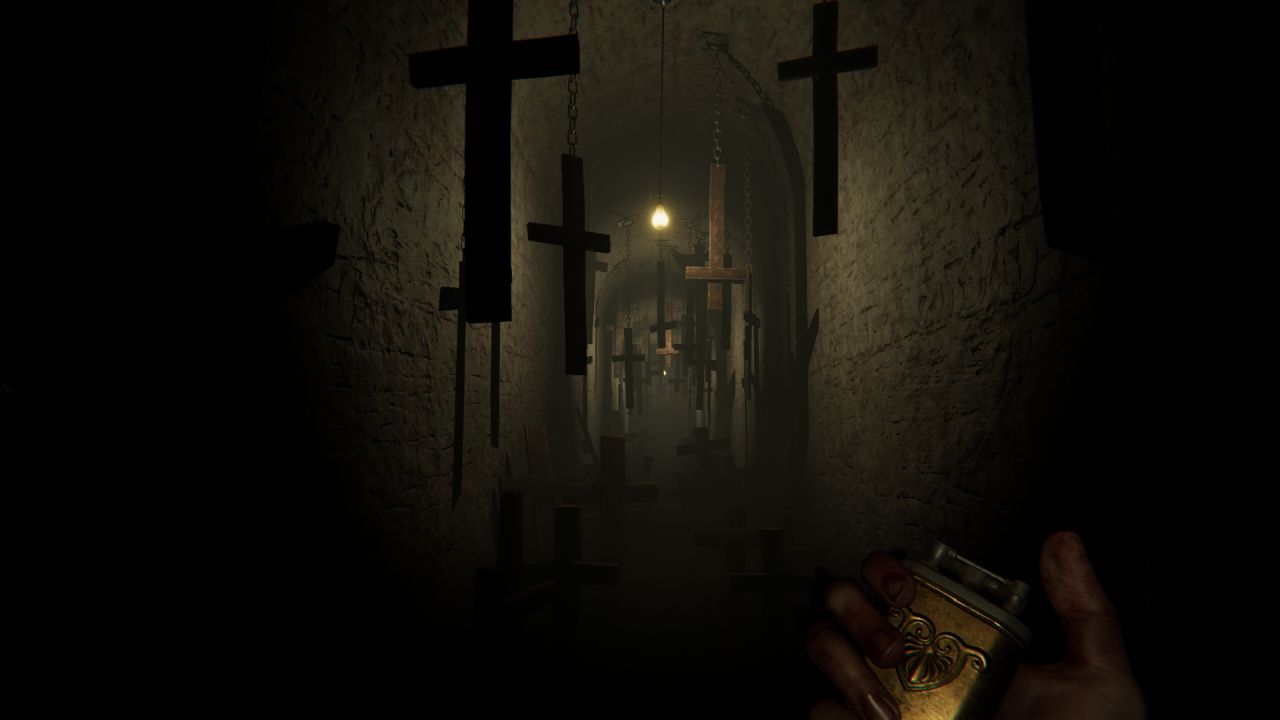The game itself sometimes makes very good choices, though it’s about 50/50 that it goes a bit too weird and ends up being silly. This makes for an intriguing mixture, especially with a complicated story of murder and neglect spanning decades, and by the end I was extremely fond of the way the sublime and the ridiculous sat side by side. The main let down isn’t that Madison sometimes makes you giggle by accident, but that its multi-stage puzzles become so drawn out that you stop jumping at creepy angels and terrifying violin squeals. You’ve got numbers to write down and candles to move, and you don’t have time for any demonic antics right now, godammit. A chunk of Madison is what you’d expect: a creepy building that plays thunder or thuds every 60-300 seconds to keep you on your toes, a hidden diary descending into barely-legible scribbles, and statues that suddenly appear or move when your back is turned. Like many horror games, there’s a bunch of perversions of Catholic-ish imagery knocking about, which can be used to frighten both Catholics and Protestants. Every other scare made me actually scared, and the remainder made me laugh. I found a toilet, chained shut, with DO NOT USE on it. In a flooded basement I nearly wet myself at a monster suddenly appearing in the dark, which was undercut when a bunch of limbs that looked like they were all way too big for its scale started levitating out of the water. In a series of dark corridors I was again terrified by demonic jump scares, until I noticed that the beast kind of looked like it was wearing a nappy. My favourite thing was discovering a priest had sent my character’s dad a very urgent message on three separate cassette tapes, because he couldn’t figure out that there new-fangled email. The very first tape advised that the easiest way to get rid of a demon is to let it have what it wants. Father! That is obviously terrible advice! Where did you go to priest school? The biggest and most unique part of the game is the camera. Much credit to the developers for using it in a way that feels far more transformative and interesting than in something like Outlast, where your little handycam is mostly a pair of night vision goggles, or Martha Is Dead, where your camera is mostly a camera. In Madison, as well as the flash illuminating dark corners, the is both a scare machine and key to solving many mysteries. Taking photos of things will reveal creepy scrawlings on the film where the wall in front of you is blank, which is an efficient and cool way to induce the creeps. Sometimes taking a snap will make a frame crack, a door open, or a demon appear. If you’re stuck in Madison then, usually, something will shake loose if you take enough photos. You probably will get stuck. Madison’s setting is a semi-derelict house, and you gradually unlock more and more of it, getting access to the master bedroom, the kitchen, the attic, and so on. You’ll have to backtrack quite a lot to solve puzzles in earlier rooms, in the process uncovering a mille-feuille of tragedy going back decades, and including a mass murder that ended in tears at bedtime and chopped up limbs. I enjoyed the show-don’t-tell complexity of it enough to be disappointed by the ending, which felt more predictable and edgy than the rest (and which would require a similar content warning to The Suicide Of Rachel Foster, if you’re keeping track). The puzzles are the bit I have more of a bone to pick with. Some rooms in the house become gateways to hallucinations that blur time and space. The attic, for example, opens up a doorway to a cathedral that exists in several different time periods. I was really enjoying this (albeit unexpectedly taking confession for a woman who murdered her Nazi husband, an inclusion whose purpose I’m still not clear on) until I ran into another of what are a few frustrating puzzles in the game. The cathedral has weird art mazes of different colours, requiring you to put colour coded candles on the right pedestals in the right bits and aaarghhhh. I got stymied in the house by spending way too long looking for a safe code when in fact I should have been in that same attic moving pictures around and doing some maths. None of these puzzles will stump you forever, but they roadblock you long enough that you will end up running up and down the house, on a search for what you missed, until the creepy music stings and menacing angel statues don’t phase you at all. “Yeah, yeah,” I muttered, as the lights flickered and a door slammed shut. “But I need to get back upstairs now, so can we move it along?” In that sense, Madison is a little too clever for its own good. For all that it can be a bit ridiculous (in an endearing way, at that) it does some genuinely great things, and really takes advantage of everything the in-game camera can offer. But at least an hour of your six-ish in the hell-house will be you swaggering back and forth angrily interacting with things you already found, until you stumble on the solution you need. This massively undercuts the pacing, to the point that the well-crafted scares and monstrous monsters stop being as effective. I’d still recommend it to a horrorficionado, but the rec isn’t as full-throated as it could have been. If the puzzle bits were a little easier, the horror bits of Madison would be able to properly shine.

